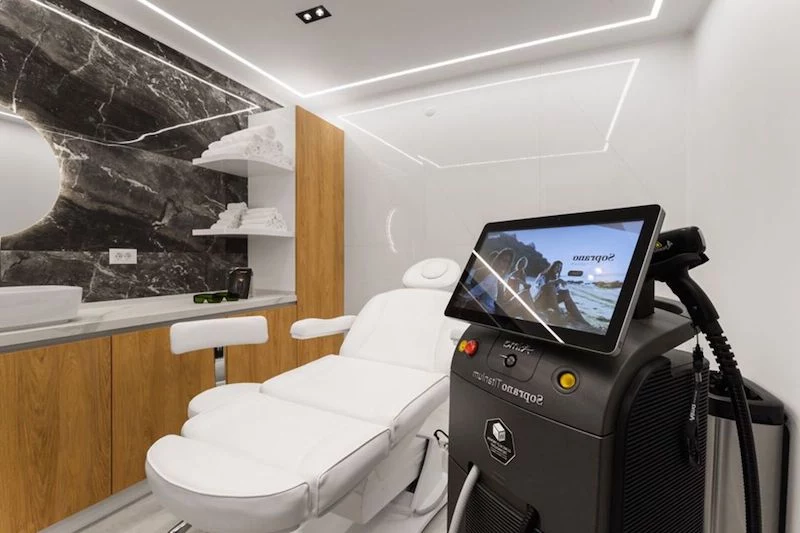The Real Deal on Laser Hair Removal: When to Start & What It Actually Costs
After years in the treatment room, I’ve heard every question imaginable about laser hair removal. But funnily enough, the one that comes up most isn’t about pain—it’s about timing. Everyone wants to know the secret to being perfectly smooth for a vacation or the summer season.
In this article
- First, How Does This Stuff Even Work?
- Why You Genuinely Need Multiple Sessions
- The Pro’s Case for Fall & Winter Treatments
- Let’s Talk About the Elephant in the Room: The Cost
- What About Those At-Home Devices?
- The Step-by-Step Process: From ‘Hello’ to Smooth Skin
- Who Is This For… And Who Should Skip It?
- Common Mistakes & What to Do
- A Worthwhile Investment in Yourself
- Inspirational Gallery
My answer is always the same: you need to start way sooner than you think, ideally when the weather gets cool and gloomy. And no, that’s not just a clever way to fill our schedules in the off-season. It’s about working with your body and the science of the laser to get you the best, safest results.
So many people get the urge for hair-free skin the second the sun comes out in spring, calling in a panic to be ready in six weeks. I then have to be the one to explain that this is a marathon, not a sprint. To really work, the process takes time and multiple sessions. Starting in the fall or winter gives us that time and sets you up for success. Let’s break down why this is the pro-level approach.

First, How Does This Stuff Even Work?
To get why timing is so critical, you have to know what the laser is actually doing. It’s not magic, it’s just targeted physics. The laser sends out a super-concentrated beam of light that’s specifically looking for pigment—in this case, the dark melanin in your hair.
When that light hits the hair, the dark pigment gobbles it up and instantly converts it to heat. This heat travels right down the hair shaft into the follicle, which is the little sac that produces the hair. The intense thermal energy damages the parts of the follicle responsible for making new hair. After enough treatments, the follicle is too damaged to produce another thick, dark hair. Voila!
The key is that medical-grade lasers are tuned to be absorbed by the hair pigment, not the pigment in your skin. This is why it works best when there’s a big contrast between your hair and skin color (think dark hair, pale skin). For darker skin tones, the pros use a different type of laser, often an Nd:YAG, which is designed with a longer wavelength to safely bypass the pigment in the skin and target the follicle more directly. Using the right tool for your skin type isn’t just a suggestion—it’s an absolute must for safety.

Why You Genuinely Need Multiple Sessions
Okay, so why can’t we just zap it all in one go? It all comes down to your hair’s growth cycle. Every single hair on your body is in one of three phases at any given time:
- The Growth Phase (Anagen): This is the magic stage. The hair is actively growing and physically connected to the follicle’s base. The laser needs this connection to send heat down to the growth center. This is the only phase where the treatment works.
- The Transition Phase (Catagen): The hair has detached from its base and is just hanging out before it eventually falls out. The laser can’t do anything here because the pathway for the heat is gone.
- The Resting Phase (Telogen): The follicle is dormant and the old hair is getting ready to shed. A laser zap during this phase is completely useless.
On any given day, only about 15-20% of your body hair is in that perfect anagen phase. That’s why we schedule sessions four to six weeks apart. It gives a whole new batch of hairs time to move into the growth phase so we can target them. Trying to come in sooner is honestly just a waste of your money—we’d just be zapping resting follicles.

The Pro’s Case for Fall & Winter Treatments
Now that the science is out of the way, it’s easy to see why the pros all recommend starting in the colder months. It’s all about controlling two huge variables: sun exposure and your skin tone.
1. Sun Exposure Is the Enemy
This is the big one. I am an absolute stickler about this with my clients. You have to stay out of the sun (and tanning beds!) for at least four weeks before and after every single session. When your skin gets tan, it produces more melanin. To the laser, that tan creates a competing target. The energy that should be going down your hair shaft gets absorbed by the skin instead.
Best case scenario? The treatment is less effective. Worst case? You can get burns, blisters, or hyperpigmentation (dark spots). I once had a client who took a sunny vacation right before her appointment and didn’t tell me. It resulted in temporary grid-like marks on her skin that took months to fade. It was a stressful lesson for her, and a reminder for me to always ask… twice. In the fall and winter, you’re naturally indoors more and wearing layers, which keeps your skin protected and ready for a safe, effective treatment.

2. It’s All About Contrast
The ideal setup for most lasers is pale skin and dark hair. Winter is when most of us are at our palest, creating the biggest possible difference between skin and hair color. This allows your technician to use more effective energy settings on the laser. More energy equals more destroyed follicles per session.
If you come in with a tan, we have to turn the energy down to keep you safe. Lower energy means a less effective treatment, which means you’ll probably need more sessions to get the result you want. And that ultimately costs you more time and money.
Let’s Talk About the Elephant in the Room: The Cost
So, what’s this investment actually going to set you back? Prices vary wildly depending on your city, the clinic’s reputation, and the tech they use, but I can give you a general ballpark.
Think of it in terms of area size. A package of 6-8 sessions for a small area like the upper lip or underarms might run you somewhere between $300 and $750. For a medium area, like a bikini line or lower arms, you might be looking at $800 to $1,500. For a large area, like full legs or a man’s back, the total package cost could be anywhere from $1,500 to over $3,000.

Yes, it’s an upfront cost, but think about the money and time you’ll save over years of waxing appointments, razors, and shaving cream. Most clinics offer payment plans or packages that can make it more manageable.
What About Those At-Home Devices?
Ah, the at-home IPL question! I get this a lot. You’ve seen the ads, and for around $200-$500, they seem like a steal. So what’s the difference?
Well, professional lasers are extremely powerful, targeted medical devices. At-home gadgets use Intense Pulsed Light (IPL), which is a broader spectrum of light and much, much less powerful. For safety reasons, they have to be. They can definitely slow hair growth and make it finer, but they rarely achieve the same level of permanent reduction as a professional laser. You also have to use them more frequently, often weekly, forever. A pro laser treatment is much more effective and, after your initial series, you may only need a yearly touch-up.
Honestly, at-home devices can be a good option for maintenance or for people with very fair skin and dark hair who have a lot of patience. But for significant, long-lasting results, especially if you have a skin tone that requires a specialized laser, a professional is the only way to go.
The Step-by-Step Process: From ‘Hello’ to Smooth Skin
A good laser journey is more than just showing up and getting zapped. It’s a structured process.
Your Pre-Appointment Checklist
Your prep makes a huge difference. Here’s what you need to do before you come in:
- Stop Plucking and Waxing: For at least 4-6 weeks before your first session, put down the tweezers and cancel that wax appointment. The laser needs the hair root to be intact in the follicle to work. Shaving is the only hair removal you should be doing.
- Shave the Area: Give the treatment area a close shave about 12-24 hours before your appointment. This leaves the hair just below the surface, which is perfect. Too long, and the laser just singes the surface hair, which hurts and wastes energy.
- Come in Clean: Arrive with clean skin. No lotions, deodorants, creams, or oils on the area. They can interfere with the laser.
During and After the Session
During the treatment, you’ll wear protective eyewear. We’ll apply a cool gel, and then we begin. Does it hurt? Yeah, a little bit. Most people say it feels like a tiny rubber band snapping against your skin. It’s quick, and most modern machines have a built-in cooling tip that blows freezing air on your skin, which helps a ton.
Afterward, your skin will likely be a bit red with some small bumps. This is actually a good sign! It means the follicles have responded to the heat.
Quick Tip: My recommended recovery kit is super simple. Grab a bottle of pure Aloe Vera Gel (around $10 at any drugstore), a good broad-spectrum mineral SPF 50 sunscreen ($15-$30), and a gentle, unscented lotion for the days that follow.
The Fun Part: Shedding!
By the way, about 1-3 weeks after your treatment, you’ll notice something amazing. The treated hairs will just start to fall out in the shower or when you gently exfoliate. This isn’t regrowth! It’s the dead hairs being pushed out of the follicle. It’s incredibly satisfying and the best proof that the treatment is working.
Who Is This For… And Who Should Skip It?
Laser is amazing, but it’s not for everyone. Honesty is key here.
You are a great candidate if you have dark hair and skin that’s on the lighter side. The contrast is what the laser loves.
However, you are likely NOT a good candidate and should avoid laser if:
- You have blonde, red, white, or grey hair (there isn’t enough pigment for the laser to target).
- You are pregnant or breastfeeding.
- You are taking photosensitizing medications, like certain antibiotics or Accutane.
- You have a history of certain skin conditions or scarring tendencies.
A thorough consultation will cover all of this, but it’s good to know going in.
Common Mistakes & What to Do
Life happens! Here are a couple of common slip-ups and how to handle them.
- “Oops, I got some sun before my appointment!” Just call us. Seriously. Don’t risk it. We will be happy to reschedule you for a few weeks later. It is so much better to delay your session than to risk a burn or pigmentation issues.
- “Oops, I forgot and plucked a hair!” Don’t panic. That one follicle just won’t be treated this round. We’ll get it on the next cycle. Just don’t make a habit of it, or you’ll be slowing down your own results.
A Worthwhile Investment in Yourself
Choosing to get laser hair removal is a big decision, and it pays to do it right. The effectiveness of your treatment hinges on the quality of the machine and, more importantly, the skill of the person using it. This isn’t the time to bargain hunt.
Look for a clinic that’s supervised by a medical professional and staffed by certified, experienced technicians. Ask them what kind of laser they use and if they have experience with your skin and hair type. A true pro will be happy to answer everything.
By planning your treatments for the fall and winter, you’re making a smart move—giving yourself the best possible shot at a safe, comfortable, and incredible outcome. You’re working with the seasons, not against them. And from my side of the laser, that’s the absolute best way to do it.
Inspirational Gallery
Tempted by those at-home IPL devices?
While convenient, it’s crucial to understand the difference. Professional, in-clinic lasers (like Alexandrite or Nd:YAG) use a highly concentrated, single wavelength of light for powerful, targeted follicle destruction. At-home IPL (Intense Pulsed Light) devices, such as the popular Philips Lumea or Braun Silk-expert Pro, use a broad spectrum of less-focused light. This makes them significantly less powerful. They are best for hair *suppression* and require ongoing, frequent use, whereas professional lasers aim for permanent hair *reduction*.
The one rule to never, ever break between sessions: Do not pluck, wax, or epilate. The laser’s energy needs the hair shaft as a conduit to travel down to the follicle and destroy it. If you pull the hair out by the root, the laser has no target, making the treatment for that specific follicle completely ineffective. Shaving is the only green-lit method of hair removal throughout your entire laser journey.
Did you know? The U.S. Food and Drug Administration (FDA) has cleared laser devices for
After your appointment, treat your skin with care. It’s just been through an intense workout and will likely feel sensitive, similar to a mild sunburn. Your main goals are to cool, soothe, and protect.
- Gently apply a pure aloe vera gel or a calming, fragrance-free moisturizer.
- Avoid hot baths, saunas, and intense exercise for at least 24 hours to prevent further irritation.
- Be relentless with sun protection. A broad-spectrum SPF 50 is non-negotiable on the treated area.
Alexandrite laser: This is the fastest laser, ideal for treating large body areas on patients with light-to-olive skin tones (Fitzpatrick types I-III).
Nd:YAG laser: This laser has a longer wavelength, making it the safest and most effective option for darker skin tones (Fitzpatrick IV-VI) as it bypasses the pigment in the skin.
Many modern machines, like the Candela GentleMax Pro or Cynosure Elite iQ, are dual-wavelength systems, containing both lasers to safely treat virtually all skin types.
Laser hair removal is no longer exclusive to women. There’s a significant rise in men seeking treatments for a permanently clean-shaven look on their back and shoulders, to reduce chest hair density, or to create a sharp, defined beard line and eliminate razor burn on the neck. The principles are the same, though denser, coarser male hair may sometimes require additional sessions.
- Less morning hassle and no more ‘razor tax’.
- Lasting confidence without the shadow of stubble.
- Freedom from the pain and mess of waxing.
The key to unlocking these benefits? Consistency. Skipping appointments or extending the time between them allows follicles to repair and re-enter the growth cycle, undermining your progress. Stick to the 4-6 week schedule recommended by your technician for the best results.
On average, women who shave spend over $10,000 and nearly 60 days of their lives managing unwanted hair.
When viewed as a long-term investment, the cost of laser hair removal shifts perspective. It’s not just a cosmetic expense; it’s a way to buy back countless hours and future dollars that would otherwise be spent on temporary solutions like razors, creams, and waxing appointments.
Your pre-treatment checklist is simple but crucial for a safe and effective session:
- Thoroughly shave the area 12 to 24 hours before your appointment.
- Arrive with clean skin, free of any lotions, oils, or deodorants.
- Avoid any sun exposure, tanning beds, or self-tanning products on the area for at least two weeks prior.
How do I choose the right clinic?
Look beyond the discount packages. A reputable provider will offer a free consultation and a patch test. Ask pointed questions: Is the operator a certified laser technician or nurse? What specific model of laser will they use? A top-tier clinic or dermatology office will be transparent about their equipment and qualifications, ensuring you’re treated with the correct technology for your specific skin and hair type, which is paramount for safety and results.










